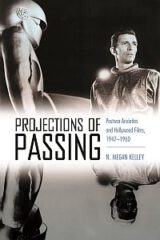The debatable term of “passing,” initially used to describe a basically 19th and 20th century strategy of African-Americans to pass for white (and avoid Jim Crow laws, absurd segregationist rules and social exclusion), in the mid- 1950s took on other forms and meanings.
 Actually, then it depicted new ways of passing/acting out or incorporating somebody else, this time not to conceal race. Movie studios, both small independent companies and the big studios, perceived this development and for a while based the plots of their productions on it.
Actually, then it depicted new ways of passing/acting out or incorporating somebody else, this time not to conceal race. Movie studios, both small independent companies and the big studios, perceived this development and for a while based the plots of their productions on it.
“The goal of this study is to explore why anxieties about passing did resonate on so many levels in the long 1950s, and analyzing films of the era is the key to understanding this. … While films are never simple mirror-images of broader sociological trends, Hollywood both reflected and exerted influence upon cultural discourse. In an era defined by anxiety and psychology, the best reflections came out of Hollywood America’s ‘Dream Factory’.”
In a post-war decade all hysterical about identity, personality and subversive forces at work, life for all nonconformist citizens of the US became rather difficult. And no longer was a black person who due to his light skin passed for white and had access to other forms of social life than his dark-skinned cousin the worst thing a WASP person could think of. Now there were more terrible fears that kept the average white American awake at night: “In the imaginative fears of postwar America, identity was under siege on all fronts: not only were there black passing as whites, but women passing as men, gays passing as straight, Communists passing as good Americans, Jews passing as Gentiles, and even aliens passing as humans (and vice versa). … While the practice of passing was rooted in social inequality, anxieties about passing were obsessed modern issues of identity and authenticity.”
N. Megan Kelley, an independent scholar with a PhD in American history from York University, connects the many cultural and social developments of that epoch as literature and generally cinema picked up those concerns, thereby both publicizing and amplifying fears. Little wonder that Method acting, largely based on personal experiences that were to be connected to whatever actor’s role to make the performer appear more authentic and “pass,” also became very popular at that time.
Her focus naturally is on film, such as the blockbusters (as well as some B-movies) that featured groups whose passing defined the story and led to problems of authentication and trust, such as Woman on Pier 13, Some Like it Hot, I Married a Monster from Outer Space, All About Eve, The Man in the Gray Flannel Suit, The Day the Earth Stood Still, Gentlemen’s Agreement, Imitation of Life, Island in the Sun, Pinky, Lost Boundaries and others.
Identity as a subject, both related to the individual and the nation, in the mid-1950s became a very unstable idea; it was challenged by many new ideas from (the new and now omnipresent focus on) psychology, anthropology, as well as psychiatric and social theories. Resulting in a situation where what formerly was called “normalcy” now was an ambivalent subject. As a means to reach millions, directors gratefully picked up the conflicts.
“While Hollywood films were obsessed with passing as a subject, passing as an act resonated in Hollywood because the industry was built and staffed by those who made a living performing, by people who invented and reinvented themselves both on-screen and off-screen. Passing imagined a malleability of identity based on performance, which challenged binary concepts. … One of the central dichotomies of postwar American culture was that on-screen public performances of acting were celebrated, while off-screen passing performances were feared.”
Kelley’s title is extremely well-researched and will help understand the many movies on characters who employ fake identities, as well as the battalion of psychological films of the 1950s, such as Johnny Guitar, The Gunfighter, The Caine Mutiny, Home of the Brave, Vertigo, The Snake Pit, Whirlpool, and others. A brilliant title, with a lot of resources and the selected movies (shot between 1947 and 1960) clarify the sometimes absurd and contradictory discourses about identity and authenticity that coexisted on a domestic level at that time. Highly recommend reading and essential literature to understand the US film business and national anxieties of the 1950s as a decade of partial reinvention of the self, search for identity, authenticity and years of introducing strategies and a vocabulary of passing for many purposes of survival. This is the first paperback edition of the 2016 title; it comes with a useful select filmography on six pages.
Review by Dr. A. Ebert © 2021
N. Megan Kelley. Projections of Passing: Postwar Anxieties and Hollywood Films, 1947-1960. University Press of Mississippi, 2021, 290 p.
